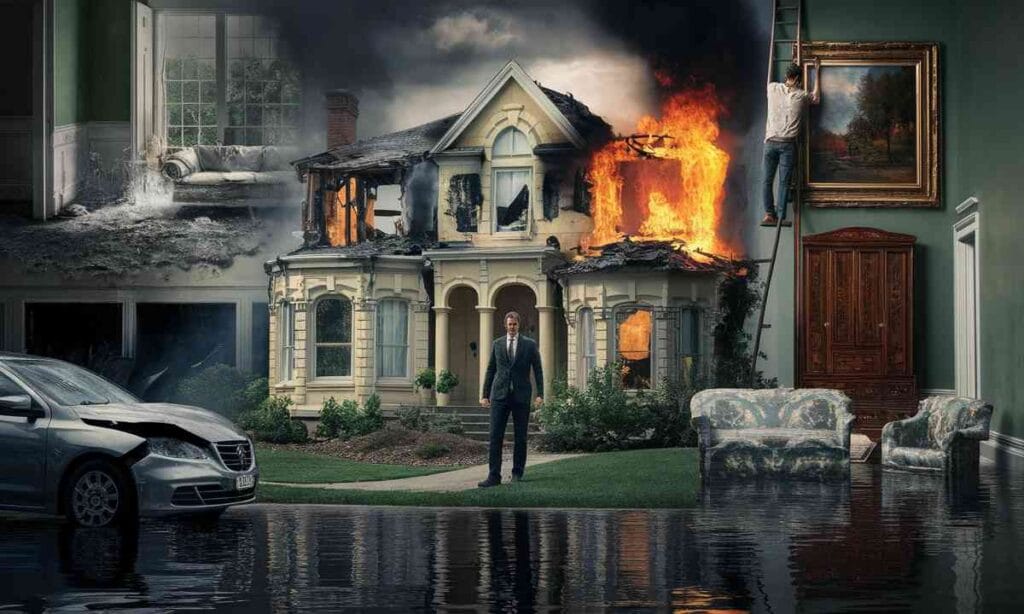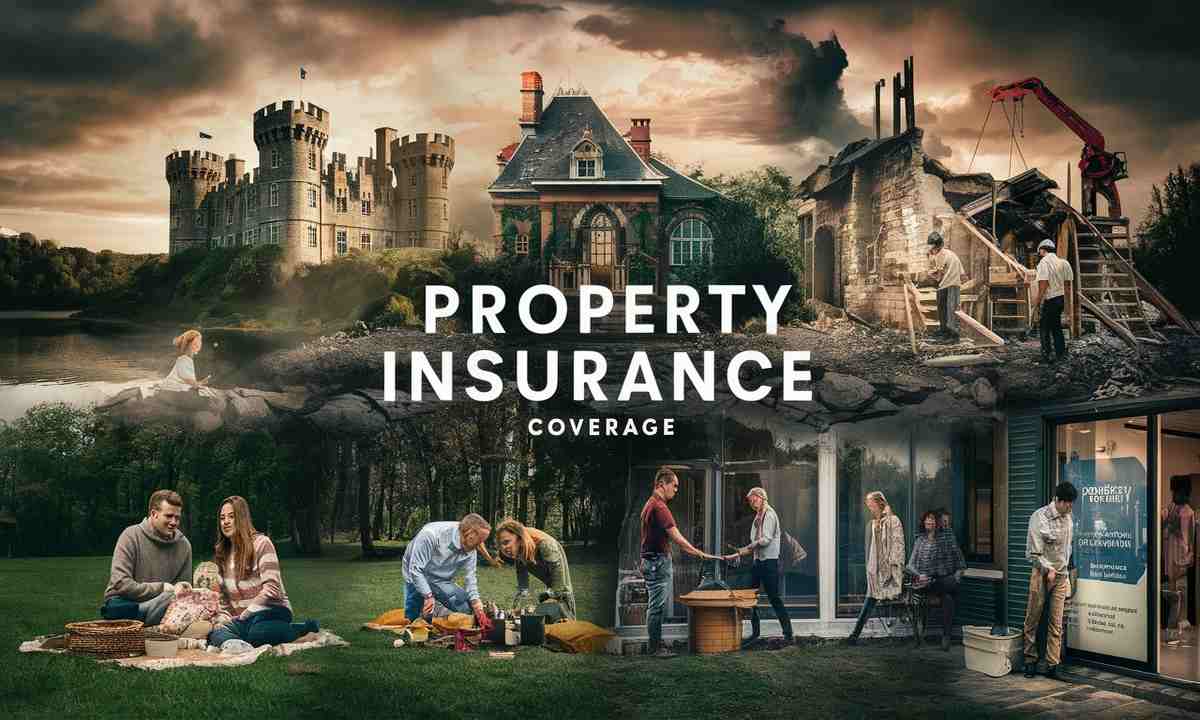TAKING in Property Insurance
Property insurance is a vital aspect of risk management, designed to protect individuals and businesses from financial losses due to damage or theft of property. This insurance encompasses various types of coverage, each tailored to address specific risks associated with property ownership and use. Its fundamental purpose is to mitigate the financial burden arising from unforeseen incidents, ensuring that policyholders can recover and rebuild without bearing excessive costs.

Definition and Purpose of Property Insurance
Property insurance refers to a broad category of insurance policies that safeguard physical assets from loss or damage. The primary objective is to provide financial compensation for repairs or replacements of property affected by covered perils. By transferring the risk of financial loss to an insurer, property owners can protect their investments and secure peace of mind, knowing that they are shielded from significant financial strain due to unexpected events.
The Importance of Property Insurance for Homeowners
For homeowners, property insurance is not merely a precaution but a crucial component of financial security. It covers a range of risks including fire, theft, vandalism, and natural disasters, ensuring that the homeowner’s primary asset— their home—is protected. Without adequate insurance, homeowners could face substantial out-of-pocket expenses to repair or replace their damaged property, making insurance an indispensable element of responsible property management.

Types of Property Insurance Policies
Property insurance encompasses various policy types, each designed to address different needs and circumstances. Understanding these types is essential to selecting the appropriate coverage for specific situations.
Homeowners Insurance
Homeowners insurance is designed to cover the physical structure of a home and the belongings within it. It includes protection against common risks such as fire, theft, and vandalism. This policy also provides liability coverage in case someone is injured on the property, making it a comprehensive choice for most homeowners.
Condo Insurance
Condo insurance, or HO-6 insurance, caters to condominium owners and provides coverage for personal property, structural improvements, and liability. It often supplements the condo association’s master policy, covering areas and possessions not included in the association’s coverage.
Renters Insurance
Renters insurance protects tenants against loss or damage to their personal belongings, as well as liability for injuries that occur within the rented premises. While it doesn’t cover the structure of the building itself, it offers essential protection for renters who need to safeguard their possessions and financial responsibilities.
Landlord Insurance
Landlord insurance, also known as rental property insurance, is designed for property owners who rent out their homes or apartments. It provides coverage for the building, liability protection, and loss of rental income in the event that the property becomes uninhabitable due to covered perils.
Commercial Property Insurance
Commercial property insurance covers buildings and assets used for business purposes. This policy protects against risks such as fire, theft, and natural disasters that could impact the business’s physical premises and operational assets.
Core Coverage Areas
Understanding the core coverage areas of property insurance is crucial for ensuring adequate protection.
Dwelling Coverage
Dwelling coverage is fundamental to property insurance, providing protection for the physical structure of the home. This includes the walls, roof, floors, and built-in appliances, covering repair or replacement costs in the event of damage from covered perils.
Protection for the Physical Structure
This protection encompasses the entire physical structure of the property, ensuring that any damage caused by incidents such as fires, storms, or vandalism is covered. It helps homeowners avoid the financial burden of significant repairs or rebuilding costs.
Examples of Covered Perils
Property insurance policies list specific perils covered under the policy. Common examples include fire, lightning, windstorm, hail, theft, and vandalism. Each policy may vary, so reviewing the list of covered perils is essential to understand what risks are included.
Other Structures Coverage
Other structures coverage extends protection to buildings on the property that are separate from the main dwelling, such as garages, sheds, and fences. This ensures that these structures are also covered in case of damage or loss.

Coverage for Detached Buildings
Detached buildings, such as guesthouses or workshops, are covered under this portion of property insurance. This coverage ensures that any damage to these structures is included under the policy’s protection.
Personal Property Coverage
Personal property coverage protects the belongings inside the home, including furniture, electronics, clothing, and other personal items. This coverage helps replace or repair items lost or damaged due to covered perils.
What’s Included in Your Belongings
This aspect of coverage includes a wide range of personal items, from everyday household goods to valuable possessions such as jewelry or art. Understanding the limits and exclusions of personal property coverage is crucial to ensure all belongings are adequately protected.
Coverage for High-Value Items
High-value items, such as expensive jewelry, artwork, or collectibles, may require additional coverage beyond standard personal property limits. Specialized endorsements or separate policies can be purchased to ensure these items are fully covered.
Additional Living Expenses Coverage
Additional living expenses coverage, also known as loss of use coverage, provides financial assistance for temporary housing and other living costs if the insured property becomes uninhabitable due to a covered loss. This ensures that policyholders are not financially burdened while their property is being repaired or rebuilt.
Temporary Housing Costs During Repairs
When significant damage renders the home uninhabitable, this coverage helps pay for temporary lodging, meals, and other necessary expenses. It ensures that homeowners can maintain their standard of living while their property undergoes repairs.
Liability Coverage
Liability coverage is an essential component of property insurance that protects against financial loss from legal claims and lawsuits. It covers legal fees, medical expenses, and settlements if someone is injured on the insured property.
Protection Against Legal Claims
Liability protection ensures that homeowners are shielded from the financial impact of legal claims resulting from accidents or injuries that occur on their property. This coverage is crucial for avoiding potentially crippling legal costs.
Coverage for Injuries on Your Property
If someone is injured on your property, liability coverage can help cover their medical expenses and legal costs associated with the injury. This aspect of coverage ensures that homeowners are not held financially responsible for accidents that occur on their premises.
Medical Payments Coverage
Medical payments coverage provides compensation for medical expenses incurred by individuals injured on the insured property, regardless of fault. This coverage offers a quick way to address minor injuries and avoid potential legal disputes.
Exclusions and Limitations
While property insurance offers extensive protection, certain exclusions and limitations apply. Understanding these aspects is crucial to fully comprehend the scope of coverage.
Common Exclusions in Property Insurance
Property insurance policies typically exclude certain risks such as flooding, earthquakes, and wear and tear. It’s important to review policy exclusions to understand what is not covered and consider additional insurance if needed.
Natural Disasters and Their Impact
Natural disasters like earthquakes, floods, and hurricanes often require separate policies or endorsements. These events are generally excluded from standard property insurance policies due to their high risk and potential for extensive damage.
Understanding Policy Limits and Deductibles
Policy limits define the maximum amount an insurer will pay for a covered loss, while deductibles are the amounts policyholders must pay out of pocket before insurance coverage kicks in. Understanding these limits helps ensure adequate coverage and manage financial expectations.
Factors Affecting Coverage and Costs
Several factors influence the coverage and costs of property insurance, impacting the overall affordability and protection level.
Home Location and Property Value
The location and value of the property play a significant role in determining insurance premiums and coverage limits. Properties in high-risk areas or with higher values typically incur higher insurance costs.
Building Materials and Construction
The materials and construction methods used in a property can affect insurance premiums. Homes built with fire-resistant materials or advanced safety features may qualify for lower rates.
Insurance Claims History
A history of frequent insurance claims can impact the cost and availability of coverage. Insurers may view frequent claims as a higher risk, leading to increased premiums or policy limitations.
Risk Factors and Their Influence
Various risk factors, such as the age of the property, local crime rates, and proximity to natural hazards, influence insurance costs and coverage options. Evaluating these factors helps in assessing the overall risk and insurance needs.
How to Review and Update Your Coverage
Regularly reviewing and updating property insurance coverage ensures that it remains adequate and relevant to current needs and circumstances.
Periodic Review of Your Policy
It’s essential to periodically review your insurance policy to ensure it reflects changes in property value, personal belongings, and risk exposure. Regular reviews help maintain optimal coverage and adjust for any changes in circumstances.
Adjusting Coverage for Renovations and Changes
Home renovations, additions, or significant changes to the property should prompt a review of insurance coverage. Ensuring that updated coverage reflects these changes prevents potential gaps in protection.
Ensuring Adequate Coverage for Valuables
High-value items and significant property improvements may require additional coverage. Evaluating and adjusting coverage for these items ensures they are adequately protected in case of loss or damage.
Choosing the Right Property Insurance Policy
Selecting the appropriate property insurance policy involves comparing options and understanding the coverage details to ensure it aligns with individual needs and risks.
Comparing Different Policy Options
Comparing various insurance policies helps identify the best coverage options for your specific needs. Factors to consider include coverage limits, exclusions, deductibles, and overall cost.
Evaluating Policy Providers and Their Reputation
Assessing the reputation and reliability of insurance providers is crucial for ensuring a positive experience and prompt claims processing. Researching customer reviews and industry ratings can aid in selecting a reputable insurer.
Understanding Policy Terms and Conditions
Thoroughly understanding the terms and conditions of an insurance policy helps avoid misunderstandings and ensures that all aspects of coverage are clear. Reading the policy document carefully is essential to grasp the full scope of protection.
Recent Trends in Property Insurance
Staying informed about recent trends in property insurance helps adapt to evolving risks and coverage options.
Innovations and Changes in Coverage Options
The insurance industry continually evolves with new innovations and changes in coverage options. Staying abreast of these developments helps ensure
access to the latest protection methods and coverage enhancements.
Impact of Climate Change on Property Insurance
Climate change has a profound impact on property insurance, affecting risk assessments and coverage options. Increased frequency of extreme weather events necessitates updated policies and risk management strategies.
Emerging Risks and Their Effect on Policies
New and emerging risks, such as cyber threats and pandemics, influence property insurance policies. Adapting to these risks ensures that coverage remains relevant and effective in addressing modern challenges.
Final Considerations
Property insurance is a critical component of financial planning, offering protection and peace of mind in the face of potential risks.
The Role of Property Insurance in Financial Planning
Incorporating property insurance into financial planning helps safeguard assets and manage risks effectively. It provides a safety net that supports financial stability and recovery in the event of property loss or damage.
Tips for Maximizing Your Property Insurance Coverage
To maximize property insurance coverage, consider regular policy reviews, adjust coverage for significant changes, and ensure adequate protection for high-value items. Effective management of insurance coverage enhances overall protection and financial security.
Frequently Asked Questions (FAQs)
What is property and casualty insurance?
Property and casualty insurance is a type of coverage that protects against losses related to property damage and legal liabilities. Property insurance covers damage to physical assets like homes and vehicles, while casualty insurance provides liability protection for legal claims resulting from injuries or accidents. This combination offers comprehensive protection for both tangible assets and financial responsibilities.
What does casualty insurance cover?
Casualty insurance primarily covers liability risks, including legal claims for bodily injury and property damage caused by the insured. This type of insurance helps protect against financial loss due to lawsuits or settlements arising from accidents, negligence, or other legal issues.
Source: Investopedia
How does property and casualty insurance differ from other types of insurance?
Property and casualty insurance differs from other types of insurance by covering both physical assets and liability risks. Unlike health or life insurance, which focus on personal well-being and mortality, property and casualty insurance addresses risks associated with property damage and legal liabilities.
Why is property and casualty insurance important?
Property and casualty insurance is crucial as it provides financial protection against significant losses from property damage and legal claims. It ensures that individuals and businesses are safeguarded from potentially devastating financial impacts resulting from accidents, theft, or damage to property.
What are common types of property and casualty insurance policies?
Common types of property and casualty insurance policies include:
- Homeowners Insurance
- Renters Insurance
- Auto Insurance
- Commercial Property Insurance
- Liability Insurance
How can I choose the right property and casualty insurance policy?
Choosing the right property and casualty insurance policy involves assessing your specific needs, comparing different policy options, and understanding coverage limits and exclusions. Evaluating factors such as the value of your property, potential risks, and your budget will help in selecting the most appropriate policy.
What factors affect the cost of property and casualty insurance?
Factors affecting the cost of property and casualty insurance include:
- The value and location of the property
- The type of coverage and policy limits
- The insured’s claims history
- The level of risk associated with the property or business
- Discounts and bundling options
Are property and casualty insurance premiums tax-deductible?
Property and casualty insurance premiums may be tax-deductible if they are related to a business or rental property. Personal insurance premiums are generally not deductible. It’s advisable to consult a tax professional for guidance on your specific situation.
What should I do if I need to file a property and casualty insurance claim?
If you need to file a property and casualty insurance claim, follow these steps:
- Contact your insurance provider to report the claim.
- Provide necessary documentation and evidence of the loss.
- Work with an adjuster to assess the damage and determine the payout.
- Keep records of all communications and expenses related to the claim.
How can property and casualty insurance protect my business?
Property and casualty insurance protects your business by covering risks such as property damage, liability for accidents, and loss of income due to covered events. It ensures that your business is financially secure against unexpected events that could otherwise disrupt operations and incur significant costs.
What are exclusions in property and casualty insurance policies?
Exclusions in property and casualty insurance policies are specific risks or scenarios that are not covered by the policy. Common exclusions include damage from natural disasters like floods and earthquakes, wear and tear, and intentional damage.
Source: The Balance
How often should I review my property and casualty insurance coverage?
You should review your property and casualty insurance coverage annually or whenever significant changes occur, such as property renovations, changes in business operations, or major life events. Regular reviews ensure that your coverage remains adequate and aligned with your current needs.
Can property and casualty insurance be bundled with other types of insurance?
Yes, property and casualty insurance can often be bundled with other types of insurance, such as auto or life insurance. Bundling policies with the same provider may lead to discounts and simplified management of your insurance needs.
What are the benefits of having property and casualty insurance?
The benefits of having property and casualty insurance include financial protection against loss or damage to property, liability coverage for legal claims, peace of mind, and compliance with legal or contractual insurance requirements.
How can I lower my property and casualty insurance premiums?
You can lower your property and casualty insurance premiums by:
- Increasing deductibles
- Bundling multiple policies
- Installing safety and security features
- Maintaining a good claims history
- Shopping around for competitive rates
Are there any common misconceptions about property and casualty insurance?
Common misconceptions about property and casualty insurance include the belief that all risks are covered, that premiums are fixed and non-negotiable, and that insurance is not necessary for certain low-risk properties. It’s important to understand policy details and shop around to avoid these misconceptions.
What is the difference between liability and property insurance?
Liability insurance covers legal claims for injuries or damages that the insured is responsible for, while property insurance covers physical damage to the insured’s own assets. Liability insurance protects against third-party claims, whereas property insurance protects the insured’s own property.
How does property and casualty insurance coverage vary by state?
Property and casualty insurance coverage can vary by state due to differences in state regulations, risks, and coverage requirements. States may have specific mandates for coverage types, limits, and exclusions, which affect how policies are structured.
What are the recent trends in property and casualty insurance?
Recent trends in property and casualty insurance include:
- Increased focus on climate change and natural disaster coverage
- Integration of technology and data analytics for risk assessment
- Growth in cyber liability insurance
- Development of more customized insurance products to address emerging risks









